LSBM100: Managing Information Technology and ERP Systems Report
VerifiedAdded on 2023/01/12
|10
|2579
|82
Report
AI Summary
This report provides an in-depth analysis of information systems and Enterprise Resource Planning (ERP) systems. It begins with an introduction to information systems, defining their role in data storage, management, and communication within an enterprise. The report explores various categories of information systems, including Transaction Processing Systems (TPS), Office Automation Systems (OAS), Management Information Systems (MIS), Decision Support Systems (DSS), Executive Information Systems (EIS), Expert Systems, and Process Controlling Systems, detailing their functions and applications. Furthermore, the report delves into ERP systems, explaining their role in integrating business processes and listing different types such as Microsoft Dynamics AX, Oracle Financials, SAP B1, and PeopleSoft. It highlights the benefits of ERP systems in real-life business scenarios, such as increased profitability, productivity, and streamlined financial functions. The report concludes with a summary of the key findings and recommendations for improving information and ERP systems within organizations, emphasizing the importance of these systems for effective business management.

ACADEMIC EASY
Paraphrase This Document
Need a fresh take? Get an instant paraphrase of this document with our AI Paraphraser

INTRODUCTION...........................................................................................................................3
Categories or classification of information system.....................................................................3
ERP systems................................................................................................................................5
Benefits of ERP systems in real life business..............................................................................6
CONCLUSION................................................................................................................................7
RECOMMENDATION...................................................................................................................8
REFERENCES................................................................................................................................9
Categories or classification of information system.....................................................................3
ERP systems................................................................................................................................5
Benefits of ERP systems in real life business..............................................................................6
CONCLUSION................................................................................................................................7
RECOMMENDATION...................................................................................................................8
REFERENCES................................................................................................................................9
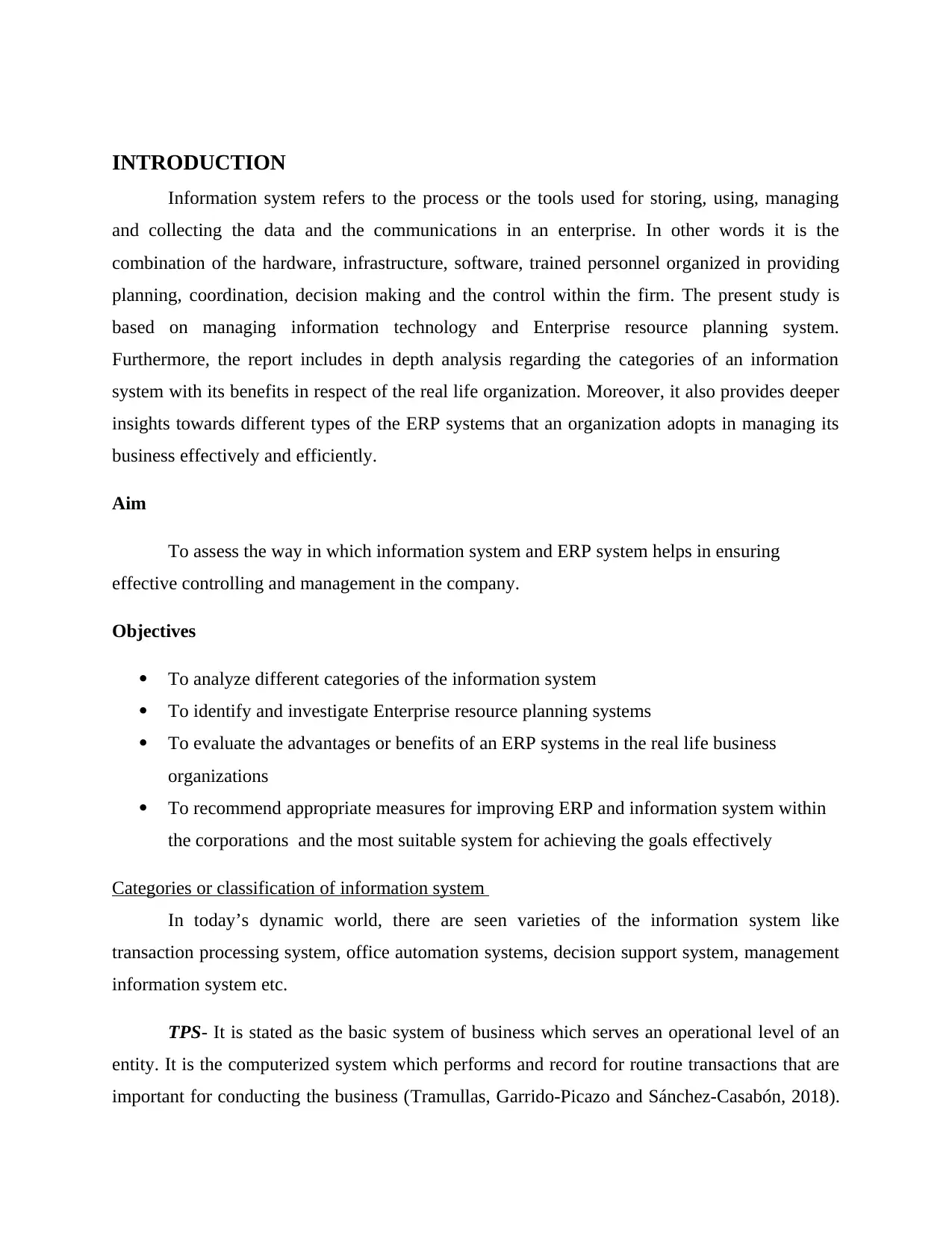
INTRODUCTION
Information system refers to the process or the tools used for storing, using, managing
and collecting the data and the communications in an enterprise. In other words it is the
combination of the hardware, infrastructure, software, trained personnel organized in providing
planning, coordination, decision making and the control within the firm. The present study is
based on managing information technology and Enterprise resource planning system.
Furthermore, the report includes in depth analysis regarding the categories of an information
system with its benefits in respect of the real life organization. Moreover, it also provides deeper
insights towards different types of the ERP systems that an organization adopts in managing its
business effectively and efficiently.
Aim
To assess the way in which information system and ERP system helps in ensuring
effective controlling and management in the company.
Objectives
To analyze different categories of the information system
To identify and investigate Enterprise resource planning systems
To evaluate the advantages or benefits of an ERP systems in the real life business
organizations
To recommend appropriate measures for improving ERP and information system within
the corporations and the most suitable system for achieving the goals effectively
Categories or classification of information system
In today’s dynamic world, there are seen varieties of the information system like
transaction processing system, office automation systems, decision support system, management
information system etc.
TPS- It is stated as the basic system of business which serves an operational level of an
entity. It is the computerized system which performs and record for routine transactions that are
important for conducting the business (Tramullas, Garrido-Picazo and Sánchez-Casabón, 2018).
Information system refers to the process or the tools used for storing, using, managing
and collecting the data and the communications in an enterprise. In other words it is the
combination of the hardware, infrastructure, software, trained personnel organized in providing
planning, coordination, decision making and the control within the firm. The present study is
based on managing information technology and Enterprise resource planning system.
Furthermore, the report includes in depth analysis regarding the categories of an information
system with its benefits in respect of the real life organization. Moreover, it also provides deeper
insights towards different types of the ERP systems that an organization adopts in managing its
business effectively and efficiently.
Aim
To assess the way in which information system and ERP system helps in ensuring
effective controlling and management in the company.
Objectives
To analyze different categories of the information system
To identify and investigate Enterprise resource planning systems
To evaluate the advantages or benefits of an ERP systems in the real life business
organizations
To recommend appropriate measures for improving ERP and information system within
the corporations and the most suitable system for achieving the goals effectively
Categories or classification of information system
In today’s dynamic world, there are seen varieties of the information system like
transaction processing system, office automation systems, decision support system, management
information system etc.
TPS- It is stated as the basic system of business which serves an operational level of an
entity. It is the computerized system which performs and record for routine transactions that are
important for conducting the business (Tramullas, Garrido-Picazo and Sánchez-Casabón, 2018).
⊘ This is a preview!⊘
Do you want full access?
Subscribe today to unlock all pages.

Trusted by 1+ million students worldwide

This system is been applied found at the supervisor y or lowest level for running the daily
activities of business smoothly or in effective manner.
Enterprise Collaboration system or OAS- It is considered as one of the most crucial used
information system which helps the managers in controlling flow of information in an enterprise.
Office automation (OAS) systems referred as the system which is not counted as particular to
any one type of management level but he facilitates support for large number of the users. This
system is been designed for providing support to the office tasks by allowing the use of
information technology. Video conferencing, voice mail, electronic mail, file transfer along with
group decisions could be achieved through the use of this system.
Management information or MIS systems- This system is reflected as the computer
information scheme which can gather and process data or information from several sources in
decision making process of an institute towards the management level. It is the system that
provides information in form of the pre-determined or specified report along with its display for
supporting decision making in business. The third level in hierarchy of an entity is been occupied
by the supervisory or lower level managers (Al-Emran and et.al., 2018). This level is comprised
of computer systems which are intended to help operational management in controlling &
ensuring transaction processing systems or activities occurred at the clerical level. This method
uses the data that had been collected by TPS in order to provide the supervisors with necessary
or essential control reports. In other words, MIS is the kind of an information system that takes
into account an internal data from system and summarizes it into the useful form as the
management reports for supporting the decision making and the activities of the management.
Decision support system- It is also a computer based method intended to be used by the
specific manager or mainly by the group of the managers at an organizational level for making
appropriate decisions in process of solving the semi-structured type of decisions. This is seen as
the company’s computerize information system that enables the managers in making decisions
that requires modeling, computing, comparing, formulating and selecting or choosing best option
for predicting the scenarios. It is particularly designed for helping management in making
decisions in the situations where there present uncertainty in relation to the possible outcomes of
the decisions. It is the computer based system that enables managers in making complex
activities of business smoothly or in effective manner.
Enterprise Collaboration system or OAS- It is considered as one of the most crucial used
information system which helps the managers in controlling flow of information in an enterprise.
Office automation (OAS) systems referred as the system which is not counted as particular to
any one type of management level but he facilitates support for large number of the users. This
system is been designed for providing support to the office tasks by allowing the use of
information technology. Video conferencing, voice mail, electronic mail, file transfer along with
group decisions could be achieved through the use of this system.
Management information or MIS systems- This system is reflected as the computer
information scheme which can gather and process data or information from several sources in
decision making process of an institute towards the management level. It is the system that
provides information in form of the pre-determined or specified report along with its display for
supporting decision making in business. The third level in hierarchy of an entity is been occupied
by the supervisory or lower level managers (Al-Emran and et.al., 2018). This level is comprised
of computer systems which are intended to help operational management in controlling &
ensuring transaction processing systems or activities occurred at the clerical level. This method
uses the data that had been collected by TPS in order to provide the supervisors with necessary
or essential control reports. In other words, MIS is the kind of an information system that takes
into account an internal data from system and summarizes it into the useful form as the
management reports for supporting the decision making and the activities of the management.
Decision support system- It is also a computer based method intended to be used by the
specific manager or mainly by the group of the managers at an organizational level for making
appropriate decisions in process of solving the semi-structured type of decisions. This is seen as
the company’s computerize information system that enables the managers in making decisions
that requires modeling, computing, comparing, formulating and selecting or choosing best option
for predicting the scenarios. It is particularly designed for helping management in making
decisions in the situations where there present uncertainty in relation to the possible outcomes of
the decisions. It is the computer based system that enables managers in making complex
Paraphrase This Document
Need a fresh take? Get an instant paraphrase of this document with our AI Paraphraser

decisions like decision required for solving poorly defined or the semi-structured type of
problems in the organization to attain the goals efficiently.
Executive information management system- This system facilitates rapid access to
internal as well as eternal information that had been presented in the graphical format but with an
ability to provide in-depth data if needed. It is the system that provides for critical information
from the wide range of internal & external sources (Chofreh, Goni and Klemeš, 2018). It
provides such information to top executives and managers that assist them in taking the strategic
and the tactical decisions. It is designed or developed for generating abstract information for
presenting the details relating to entire operations of the firm in a simplified manner for
satisfying the senior management.
Expert system- This is seen as the knowledge based method or system which provides an
expert advice and acts as the expert consultant to the users. It is the computer program which
tries in emulating human reasoning. It is the system that is indicated as the set of the computer
programs which performs the task at a level of human expert.
Process controlling systems- It refers to the system that monitors & controls physical and
an industrial processes. This system is been comprised of equipments, operating process and the
computer programs. Thus, it helps the managers in controlling the processes within the
organization in an effective way.
ERP systems
It is referred as the practice that is used by organizations in managing and integrating the
most important or significant parts of their respective businesses. Many of the ERP software
applications are crucial to the companies as they assist them in implementing the resource
planning through an integration of all the processes required for running their enterprise with the
use of single system (Alomari and et.al., 2018). This system could also integrate purchasing,
planning, marketing, sales, inventory, human resources, finance and many more. ERP solutions
have seen as evolved over years and most of are now working as web-based apps which users
could access remotely.
ERP is a centralized program that caters tight integration with all big companies functions are it
planning, consumer relations, human resource, analytics or finance, as well to other connected
problems in the organization to attain the goals efficiently.
Executive information management system- This system facilitates rapid access to
internal as well as eternal information that had been presented in the graphical format but with an
ability to provide in-depth data if needed. It is the system that provides for critical information
from the wide range of internal & external sources (Chofreh, Goni and Klemeš, 2018). It
provides such information to top executives and managers that assist them in taking the strategic
and the tactical decisions. It is designed or developed for generating abstract information for
presenting the details relating to entire operations of the firm in a simplified manner for
satisfying the senior management.
Expert system- This is seen as the knowledge based method or system which provides an
expert advice and acts as the expert consultant to the users. It is the computer program which
tries in emulating human reasoning. It is the system that is indicated as the set of the computer
programs which performs the task at a level of human expert.
Process controlling systems- It refers to the system that monitors & controls physical and
an industrial processes. This system is been comprised of equipments, operating process and the
computer programs. Thus, it helps the managers in controlling the processes within the
organization in an effective way.
ERP systems
It is referred as the practice that is used by organizations in managing and integrating the
most important or significant parts of their respective businesses. Many of the ERP software
applications are crucial to the companies as they assist them in implementing the resource
planning through an integration of all the processes required for running their enterprise with the
use of single system (Alomari and et.al., 2018). This system could also integrate purchasing,
planning, marketing, sales, inventory, human resources, finance and many more. ERP solutions
have seen as evolved over years and most of are now working as web-based apps which users
could access remotely.
ERP is a centralized program that caters tight integration with all big companies functions are it
planning, consumer relations, human resource, analytics or finance, as well to other connected
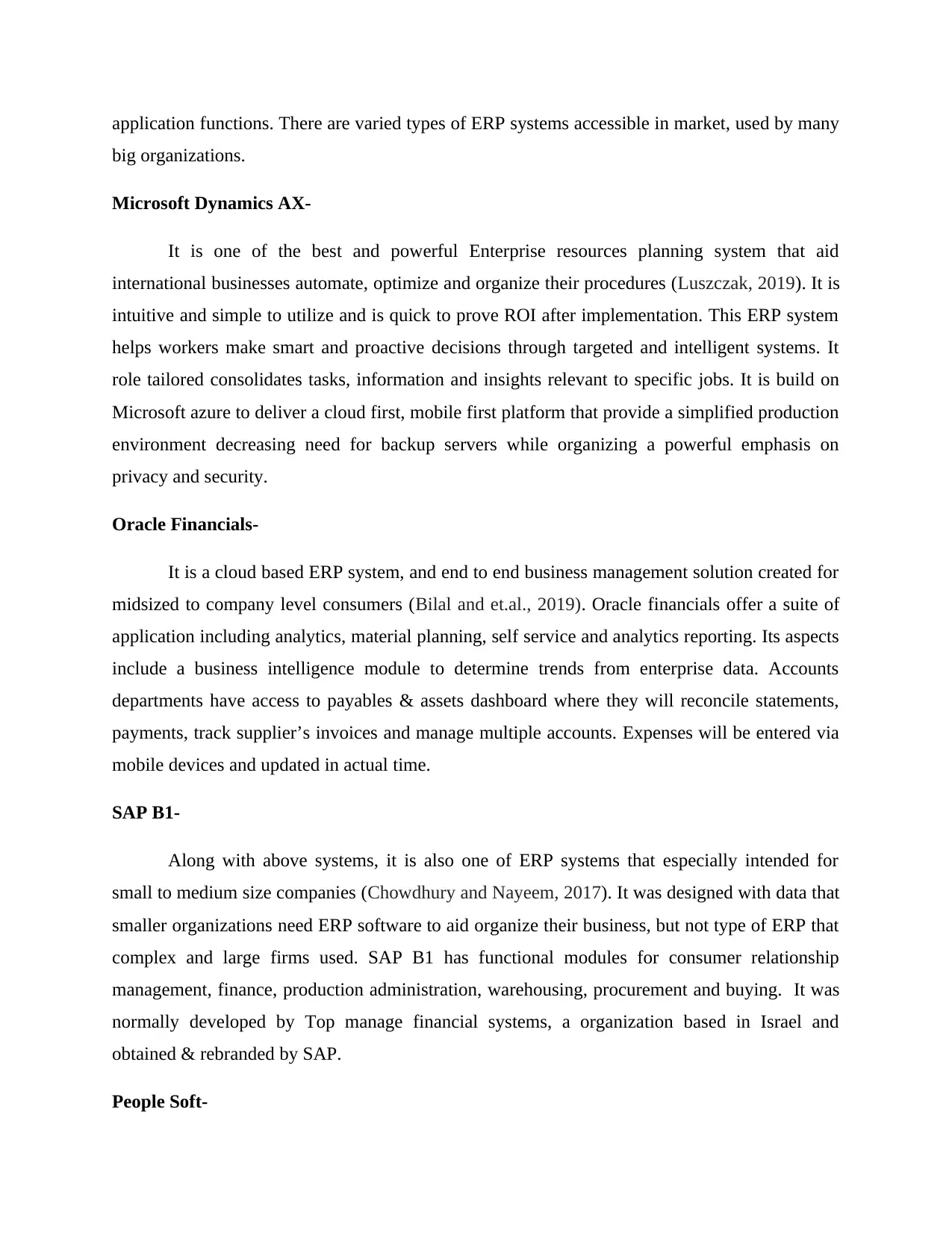
application functions. There are varied types of ERP systems accessible in market, used by many
big organizations.
Microsoft Dynamics AX-
It is one of the best and powerful Enterprise resources planning system that aid
international businesses automate, optimize and organize their procedures (Luszczak, 2019). It is
intuitive and simple to utilize and is quick to prove ROI after implementation. This ERP system
helps workers make smart and proactive decisions through targeted and intelligent systems. It
role tailored consolidates tasks, information and insights relevant to specific jobs. It is build on
Microsoft azure to deliver a cloud first, mobile first platform that provide a simplified production
environment decreasing need for backup servers while organizing a powerful emphasis on
privacy and security.
Oracle Financials-
It is a cloud based ERP system, and end to end business management solution created for
midsized to company level consumers (Bilal and et.al., 2019). Oracle financials offer a suite of
application including analytics, material planning, self service and analytics reporting. Its aspects
include a business intelligence module to determine trends from enterprise data. Accounts
departments have access to payables & assets dashboard where they will reconcile statements,
payments, track supplier’s invoices and manage multiple accounts. Expenses will be entered via
mobile devices and updated in actual time.
SAP B1-
Along with above systems, it is also one of ERP systems that especially intended for
small to medium size companies (Chowdhury and Nayeem, 2017). It was designed with data that
smaller organizations need ERP software to aid organize their business, but not type of ERP that
complex and large firms used. SAP B1 has functional modules for consumer relationship
management, finance, production administration, warehousing, procurement and buying. It was
normally developed by Top manage financial systems, a organization based in Israel and
obtained & rebranded by SAP.
People Soft-
big organizations.
Microsoft Dynamics AX-
It is one of the best and powerful Enterprise resources planning system that aid
international businesses automate, optimize and organize their procedures (Luszczak, 2019). It is
intuitive and simple to utilize and is quick to prove ROI after implementation. This ERP system
helps workers make smart and proactive decisions through targeted and intelligent systems. It
role tailored consolidates tasks, information and insights relevant to specific jobs. It is build on
Microsoft azure to deliver a cloud first, mobile first platform that provide a simplified production
environment decreasing need for backup servers while organizing a powerful emphasis on
privacy and security.
Oracle Financials-
It is a cloud based ERP system, and end to end business management solution created for
midsized to company level consumers (Bilal and et.al., 2019). Oracle financials offer a suite of
application including analytics, material planning, self service and analytics reporting. Its aspects
include a business intelligence module to determine trends from enterprise data. Accounts
departments have access to payables & assets dashboard where they will reconcile statements,
payments, track supplier’s invoices and manage multiple accounts. Expenses will be entered via
mobile devices and updated in actual time.
SAP B1-
Along with above systems, it is also one of ERP systems that especially intended for
small to medium size companies (Chowdhury and Nayeem, 2017). It was designed with data that
smaller organizations need ERP software to aid organize their business, but not type of ERP that
complex and large firms used. SAP B1 has functional modules for consumer relationship
management, finance, production administration, warehousing, procurement and buying. It was
normally developed by Top manage financial systems, a organization based in Israel and
obtained & rebranded by SAP.
People Soft-
⊘ This is a preview!⊘
Do you want full access?
Subscribe today to unlock all pages.

Trusted by 1+ million students worldwide
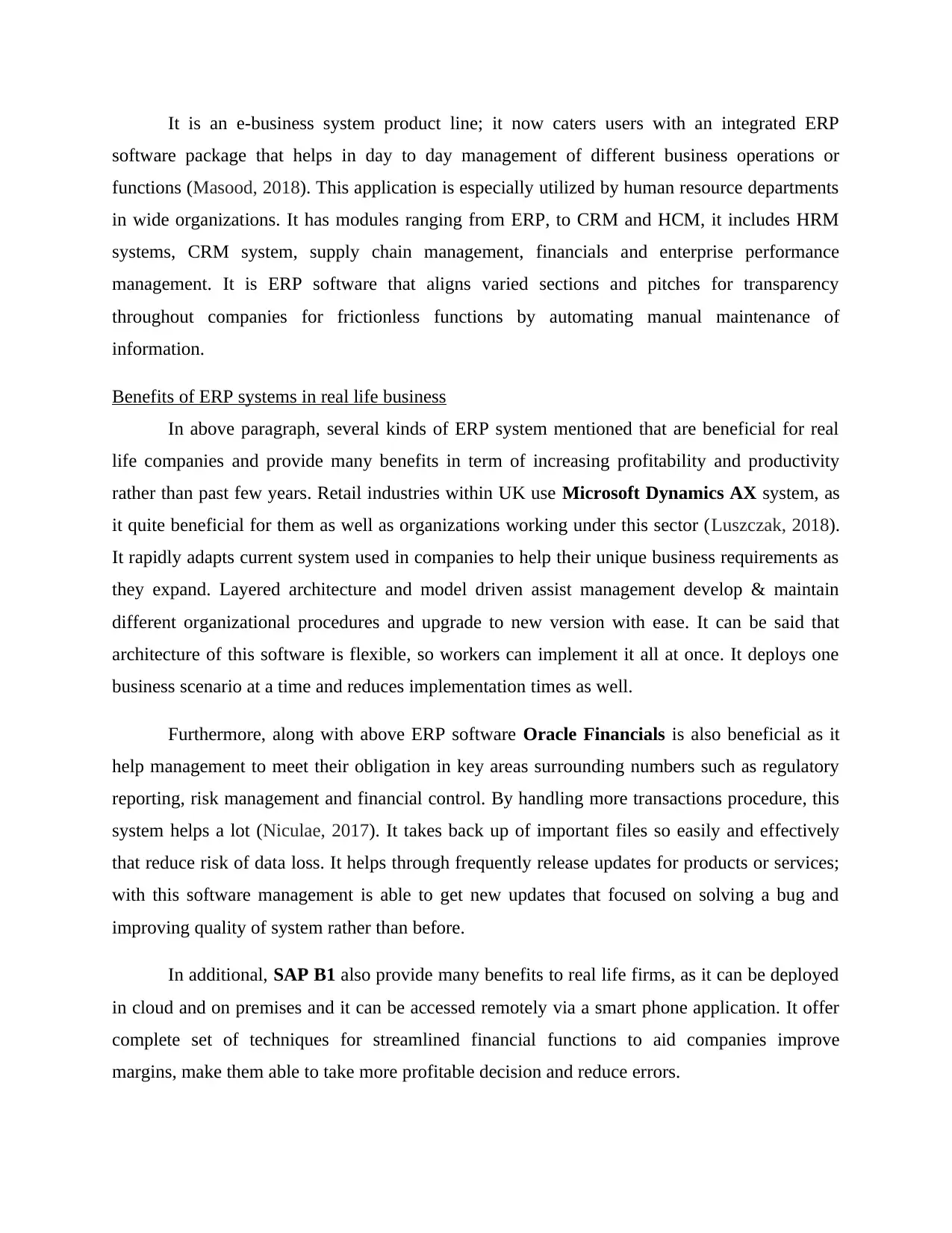
It is an e-business system product line; it now caters users with an integrated ERP
software package that helps in day to day management of different business operations or
functions (Masood, 2018). This application is especially utilized by human resource departments
in wide organizations. It has modules ranging from ERP, to CRM and HCM, it includes HRM
systems, CRM system, supply chain management, financials and enterprise performance
management. It is ERP software that aligns varied sections and pitches for transparency
throughout companies for frictionless functions by automating manual maintenance of
information.
Benefits of ERP systems in real life business
In above paragraph, several kinds of ERP system mentioned that are beneficial for real
life companies and provide many benefits in term of increasing profitability and productivity
rather than past few years. Retail industries within UK use Microsoft Dynamics AX system, as
it quite beneficial for them as well as organizations working under this sector (Luszczak, 2018).
It rapidly adapts current system used in companies to help their unique business requirements as
they expand. Layered architecture and model driven assist management develop & maintain
different organizational procedures and upgrade to new version with ease. It can be said that
architecture of this software is flexible, so workers can implement it all at once. It deploys one
business scenario at a time and reduces implementation times as well.
Furthermore, along with above ERP software Oracle Financials is also beneficial as it
help management to meet their obligation in key areas surrounding numbers such as regulatory
reporting, risk management and financial control. By handling more transactions procedure, this
system helps a lot (Niculae, 2017). It takes back up of important files so easily and effectively
that reduce risk of data loss. It helps through frequently release updates for products or services;
with this software management is able to get new updates that focused on solving a bug and
improving quality of system rather than before.
In additional, SAP B1 also provide many benefits to real life firms, as it can be deployed
in cloud and on premises and it can be accessed remotely via a smart phone application. It offer
complete set of techniques for streamlined financial functions to aid companies improve
margins, make them able to take more profitable decision and reduce errors.
software package that helps in day to day management of different business operations or
functions (Masood, 2018). This application is especially utilized by human resource departments
in wide organizations. It has modules ranging from ERP, to CRM and HCM, it includes HRM
systems, CRM system, supply chain management, financials and enterprise performance
management. It is ERP software that aligns varied sections and pitches for transparency
throughout companies for frictionless functions by automating manual maintenance of
information.
Benefits of ERP systems in real life business
In above paragraph, several kinds of ERP system mentioned that are beneficial for real
life companies and provide many benefits in term of increasing profitability and productivity
rather than past few years. Retail industries within UK use Microsoft Dynamics AX system, as
it quite beneficial for them as well as organizations working under this sector (Luszczak, 2018).
It rapidly adapts current system used in companies to help their unique business requirements as
they expand. Layered architecture and model driven assist management develop & maintain
different organizational procedures and upgrade to new version with ease. It can be said that
architecture of this software is flexible, so workers can implement it all at once. It deploys one
business scenario at a time and reduces implementation times as well.
Furthermore, along with above ERP software Oracle Financials is also beneficial as it
help management to meet their obligation in key areas surrounding numbers such as regulatory
reporting, risk management and financial control. By handling more transactions procedure, this
system helps a lot (Niculae, 2017). It takes back up of important files so easily and effectively
that reduce risk of data loss. It helps through frequently release updates for products or services;
with this software management is able to get new updates that focused on solving a bug and
improving quality of system rather than before.
In additional, SAP B1 also provide many benefits to real life firms, as it can be deployed
in cloud and on premises and it can be accessed remotely via a smart phone application. It offer
complete set of techniques for streamlined financial functions to aid companies improve
margins, make them able to take more profitable decision and reduce errors.
Paraphrase This Document
Need a fresh take? Get an instant paraphrase of this document with our AI Paraphraser
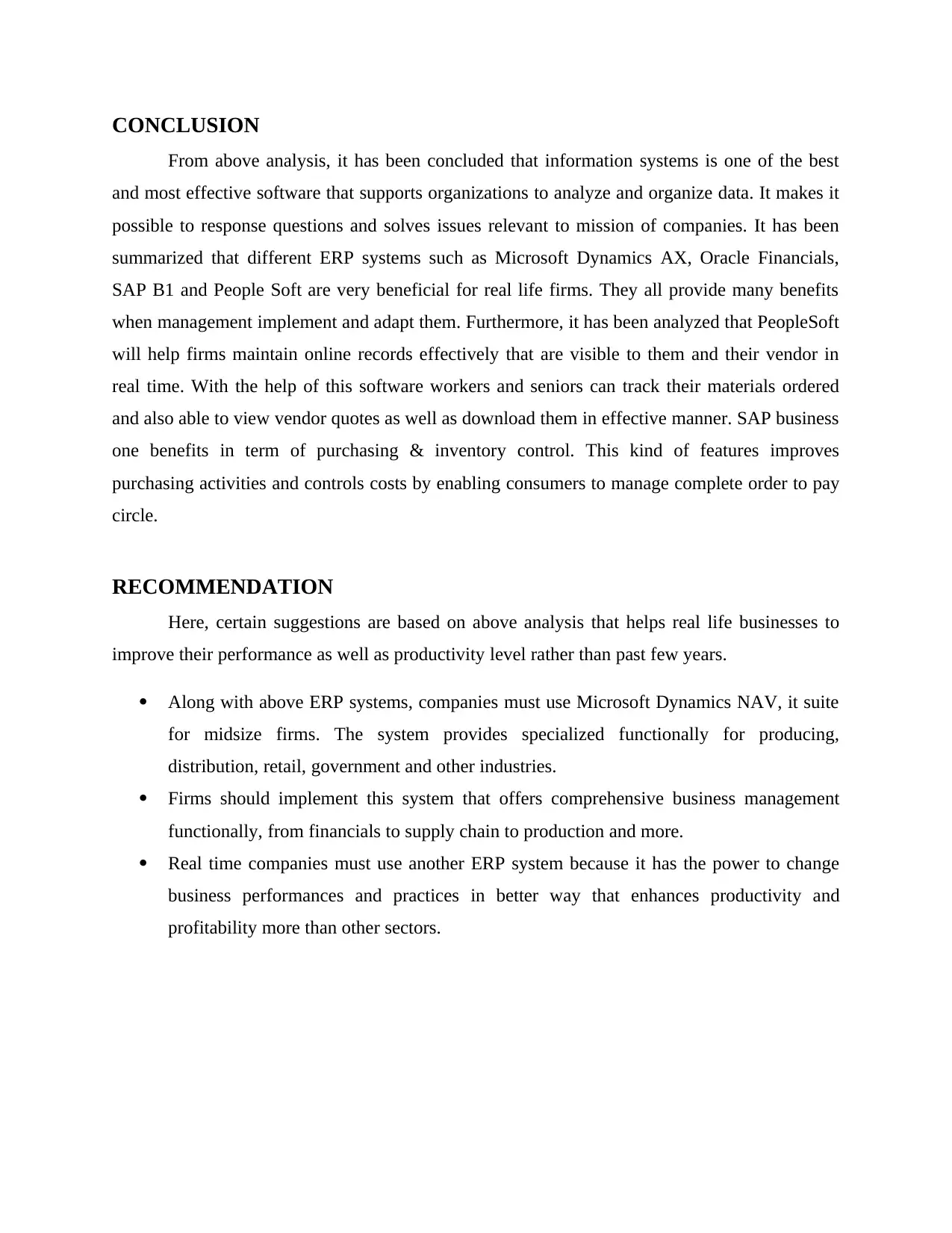
CONCLUSION
From above analysis, it has been concluded that information systems is one of the best
and most effective software that supports organizations to analyze and organize data. It makes it
possible to response questions and solves issues relevant to mission of companies. It has been
summarized that different ERP systems such as Microsoft Dynamics AX, Oracle Financials,
SAP B1 and People Soft are very beneficial for real life firms. They all provide many benefits
when management implement and adapt them. Furthermore, it has been analyzed that PeopleSoft
will help firms maintain online records effectively that are visible to them and their vendor in
real time. With the help of this software workers and seniors can track their materials ordered
and also able to view vendor quotes as well as download them in effective manner. SAP business
one benefits in term of purchasing & inventory control. This kind of features improves
purchasing activities and controls costs by enabling consumers to manage complete order to pay
circle.
RECOMMENDATION
Here, certain suggestions are based on above analysis that helps real life businesses to
improve their performance as well as productivity level rather than past few years.
Along with above ERP systems, companies must use Microsoft Dynamics NAV, it suite
for midsize firms. The system provides specialized functionally for producing,
distribution, retail, government and other industries.
Firms should implement this system that offers comprehensive business management
functionally, from financials to supply chain to production and more.
Real time companies must use another ERP system because it has the power to change
business performances and practices in better way that enhances productivity and
profitability more than other sectors.
From above analysis, it has been concluded that information systems is one of the best
and most effective software that supports organizations to analyze and organize data. It makes it
possible to response questions and solves issues relevant to mission of companies. It has been
summarized that different ERP systems such as Microsoft Dynamics AX, Oracle Financials,
SAP B1 and People Soft are very beneficial for real life firms. They all provide many benefits
when management implement and adapt them. Furthermore, it has been analyzed that PeopleSoft
will help firms maintain online records effectively that are visible to them and their vendor in
real time. With the help of this software workers and seniors can track their materials ordered
and also able to view vendor quotes as well as download them in effective manner. SAP business
one benefits in term of purchasing & inventory control. This kind of features improves
purchasing activities and controls costs by enabling consumers to manage complete order to pay
circle.
RECOMMENDATION
Here, certain suggestions are based on above analysis that helps real life businesses to
improve their performance as well as productivity level rather than past few years.
Along with above ERP systems, companies must use Microsoft Dynamics NAV, it suite
for midsize firms. The system provides specialized functionally for producing,
distribution, retail, government and other industries.
Firms should implement this system that offers comprehensive business management
functionally, from financials to supply chain to production and more.
Real time companies must use another ERP system because it has the power to change
business performances and practices in better way that enhances productivity and
profitability more than other sectors.
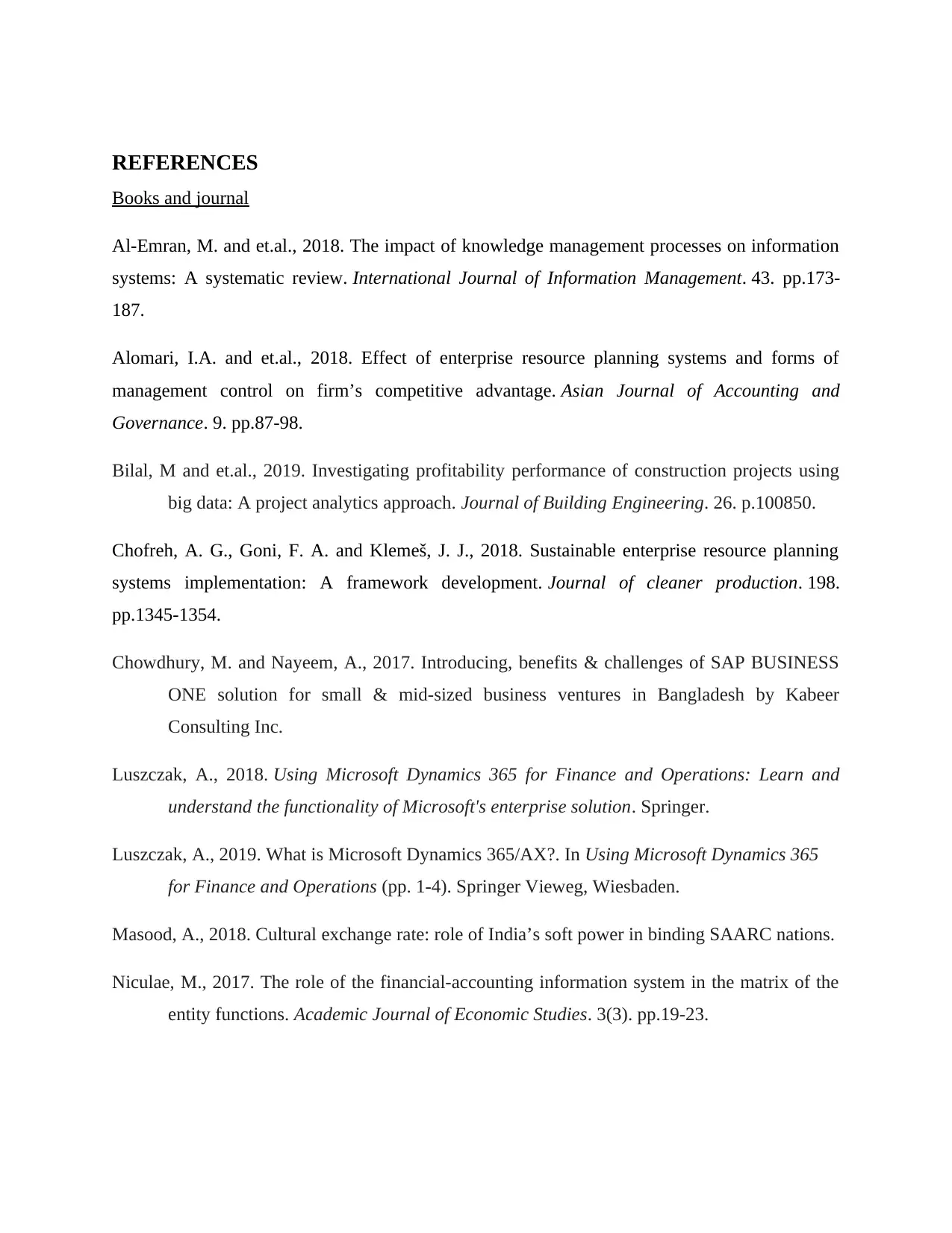
REFERENCES
Books and journal
Al-Emran, M. and et.al., 2018. The impact of knowledge management processes on information
systems: A systematic review. International Journal of Information Management. 43. pp.173-
187.
Alomari, I.A. and et.al., 2018. Effect of enterprise resource planning systems and forms of
management control on firm’s competitive advantage. Asian Journal of Accounting and
Governance. 9. pp.87-98.
Bilal, M and et.al., 2019. Investigating profitability performance of construction projects using
big data: A project analytics approach. Journal of Building Engineering. 26. p.100850.
Chofreh, A. G., Goni, F. A. and Klemeš, J. J., 2018. Sustainable enterprise resource planning
systems implementation: A framework development. Journal of cleaner production. 198.
pp.1345-1354.
Chowdhury, M. and Nayeem, A., 2017. Introducing, benefits & challenges of SAP BUSINESS
ONE solution for small & mid-sized business ventures in Bangladesh by Kabeer
Consulting Inc.
Luszczak, A., 2018. Using Microsoft Dynamics 365 for Finance and Operations: Learn and
understand the functionality of Microsoft's enterprise solution. Springer.
Luszczak, A., 2019. What is Microsoft Dynamics 365/AX?. In Using Microsoft Dynamics 365
for Finance and Operations (pp. 1-4). Springer Vieweg, Wiesbaden.
Masood, A., 2018. Cultural exchange rate: role of India’s soft power in binding SAARC nations.
Niculae, M., 2017. The role of the financial-accounting information system in the matrix of the
entity functions. Academic Journal of Economic Studies. 3(3). pp.19-23.
Books and journal
Al-Emran, M. and et.al., 2018. The impact of knowledge management processes on information
systems: A systematic review. International Journal of Information Management. 43. pp.173-
187.
Alomari, I.A. and et.al., 2018. Effect of enterprise resource planning systems and forms of
management control on firm’s competitive advantage. Asian Journal of Accounting and
Governance. 9. pp.87-98.
Bilal, M and et.al., 2019. Investigating profitability performance of construction projects using
big data: A project analytics approach. Journal of Building Engineering. 26. p.100850.
Chofreh, A. G., Goni, F. A. and Klemeš, J. J., 2018. Sustainable enterprise resource planning
systems implementation: A framework development. Journal of cleaner production. 198.
pp.1345-1354.
Chowdhury, M. and Nayeem, A., 2017. Introducing, benefits & challenges of SAP BUSINESS
ONE solution for small & mid-sized business ventures in Bangladesh by Kabeer
Consulting Inc.
Luszczak, A., 2018. Using Microsoft Dynamics 365 for Finance and Operations: Learn and
understand the functionality of Microsoft's enterprise solution. Springer.
Luszczak, A., 2019. What is Microsoft Dynamics 365/AX?. In Using Microsoft Dynamics 365
for Finance and Operations (pp. 1-4). Springer Vieweg, Wiesbaden.
Masood, A., 2018. Cultural exchange rate: role of India’s soft power in binding SAARC nations.
Niculae, M., 2017. The role of the financial-accounting information system in the matrix of the
entity functions. Academic Journal of Economic Studies. 3(3). pp.19-23.
⊘ This is a preview!⊘
Do you want full access?
Subscribe today to unlock all pages.

Trusted by 1+ million students worldwide

Tramullas, J., Garrido-Picazo, P. and Sánchez-Casabón, A. I., 2018, June. Use of Wikipedia
categories on information retrieval research: a brief review. In Proceedings of the 5th Spanish
Conference on Information Retrieval (pp. 1-4).
categories on information retrieval research: a brief review. In Proceedings of the 5th Spanish
Conference on Information Retrieval (pp. 1-4).
1 out of 10
Related Documents
Your All-in-One AI-Powered Toolkit for Academic Success.
+13062052269
info@desklib.com
Available 24*7 on WhatsApp / Email
![[object Object]](/_next/static/media/star-bottom.7253800d.svg)
Unlock your academic potential
Copyright © 2020–2025 A2Z Services. All Rights Reserved. Developed and managed by ZUCOL.





